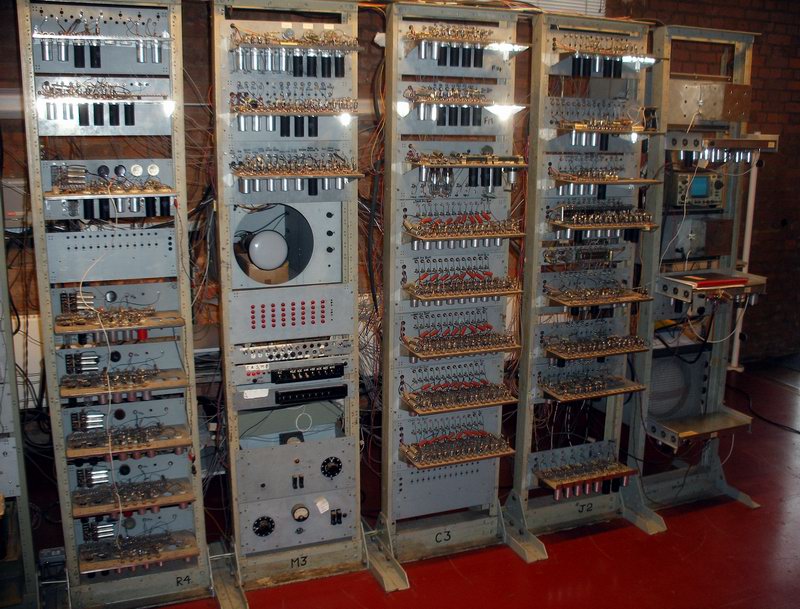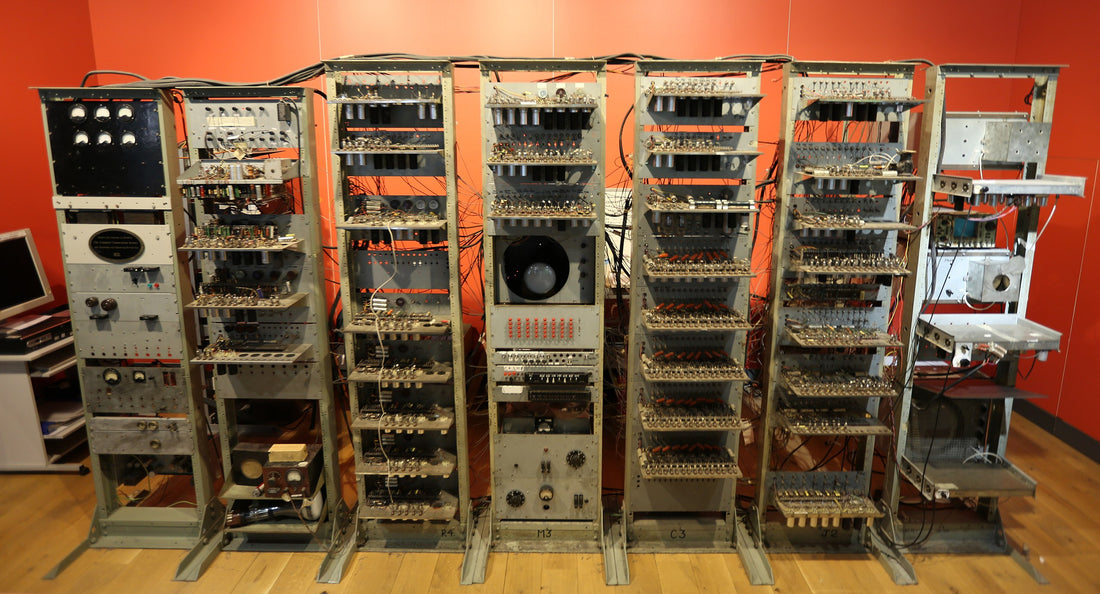At The Manchester Shop, we’re incredibly proud to be from a city with so many important contributions to science and industry. So, in this article we’re celebrating Manchester's most important contributors and the city’s long legacy in science and innovation - a journey that spans centuries. This complex city, often hailed as the birthplace of the Industrial Revolution, has been a hotbed of scientific breakthroughs influencing a broad spectrum of fields from chemistry to computer science. So here’s our spotlight on Manchester's scientific heritage, looking at the trailblazers and their groundbreaking discoveries in this city that have left an indelible mark on the world.
Chemistry
John Dalton - The Father of Modern Chemistry

John Dalton, born in Manchester in 1766, revolutionised the world of chemistry with his atomic theory. His groundbreaking work laid the foundation for modern chemistry and deeply influenced how we understand the nature of matter.
Dalton's early life and education in Manchester set the stage for his future scientific endeavours. Despite modest beginnings and limited formal education, his keen interest in meteorology and the natural sciences led him to significant discoveries.
Dalton's most notable contribution was his atomic theory, proposed in the early 19th century. He postulated that all matter is composed of small, indivisible particles called atoms, each with its own unique weight. This theory, though refined over time, remains a fundamental principle of chemistry today.
Dalton's work in Manchester not only transformed the field of chemistry but also had a profound impact on the scientific community worldwide. His legacy is still celebrated in Manchester and beyond, with institutions and landmarks named in his honour such as the John Dalton Library - covered in our Manchester Architecture & Landmarks article.
Engineering & Industry
Samuel Crompton: Innovator of the Industrial Revolution
Samuel Crompton, another Manchester-born pioneer, played a crucial role in the Industrial Revolution in Manchester, with his invention of the spinning mule.
Crompton's spinning mule, a hybrid of the spinning jenny and the water frame, revolutionised textile manufacturing. It allowed for the production of finer, stronger, and more consistent yarn, contributing significantly to Manchester's booming textile industry.
Despite his genius, Crompton faced financial difficulties and received limited recognition during his lifetime. However, his invention is now recognised as a pivotal development in industrial technology.
Sir Joseph Whitworth - Master of Precision Engineering

Sir Joseph Whitworth, born in Stockport, near Manchester, was a pioneering engineer known for his contributions to precision engineering and standardisation.
Whitworth's work on standardising screw threads was vital for the advancement of engineering. His system, known as the Whitworth standard, was widely adopted and remains influential.
Beyond standardisation, Whitworth also made significant advancements in firearm technology and manufacturing processes, enhancing the efficiency and quality of production.
These early pioneers from Manchester played instrumental roles in shaping modern science and technology. Their contributions, spanning chemistry, industrial manufacturing, and engineering, laid the groundwork for countless advancements and continue to inspire current and future generations of scientists and engineers.
Computing

The Manchester Mark 1 - A Milestone in Computing
One of the most significant contributions to computing from Manchester was the development of the Manchester Mark 1. This machine, designed and built at the University of Manchester, marked a critical step in the evolution of computers.
The Manchester Mark 1 was developed by Frederic C. Williams and Tom Kilburn, and filled an entire room! Their collaboration resulted in the creation of a machine that laid the groundwork for the development of modern computers.
The Manchester Mark 1 was notable for being one of the first computers to incorporate a stored-program architecture, an essential feature of virtually all modern computers. This architecture allowed the machine to store instructions in its memory, making it more versatile and powerful than earlier computers.
Alan Turing - A Visionary in Computing and AI

Alan Turing, a pioneering mathematician and computer scientist perhaps most famous for cracking the Enigma code in WW2, spent a significant part of his career in Manchester, where he made remarkable contributions to the development of computer science and artificial intelligence.
At the University of Manchester, Turing continued his groundbreaking work. He was particularly interested in the potential of computers to simulate human thought processes, laying the foundations for the field of artificial intelligence.
Turing's work, including his development of the Turing Test and concepts in machine intelligence, has had a lasting impact on the field of computer science. His ideas continue to influence contemporary discussions and developments in AI.
Sadly, Turing took his own life in 1954, after being prosecuted for ‘homosexual acts’. He was later posthumously pardoned by The Queen in 2013.
The contributions of Williams, Kilburn, and Turing, along with the development of the Manchester Mark 1, highlight Manchester's crucial role in the birth and growth of computing. This legacy is not just of historical significance; it continues to inspire and shape the field of computer science today.
Physics
Manchester has also been a focal point for some of the most significant advancements in the field of physics, playing a pivotal role in shaping the modern understanding of physics through the work of several eminent scientists.
Ernest Rutherford and the Birth of Nuclear Science

Ernest Rutherford, often referred to as the father of nuclear physics, made some of his most significant discoveries while working at the University of Manchester.
Rutherford's groundbreaking experiments in Manchester led to the discovery of the concept of the atomic nucleus. His work on the scattering of alpha particles and the interpretation of these results fundamentally changed the scientific understanding of the atomic structure.
Rutherford's contributions laid the foundation for modern nuclear science and technology. His insights into the structure of atoms have had far-reaching implications, not just in physics, but in chemistry, medicine, and energy.
James Joule and the Foundations of Thermodynamics
James Joule, a physicist born in Salford, Greater Manchester, made significant contributions to the field of thermodynamics.
Joule is best known for his work on the law of conservation of energy. His experiments, including the famous "Joule's Apparatus", demonstrated the conversion of mechanical energy into heat, leading to the formulation of the first law of thermodynamics.
Joule's work has had a profound impact on both physics and engineering. His discoveries laid the groundwork for the development of the energy sector and have informed countless scientific and industrial processes.
Sir Bernard Lovell and the Jodrell Bank Observatory

Sir Bernard Lovell's contributions to radio astronomy were largely centred around the Jodrell Bank Observatory, located in Cheshire near Manchester.
The Jodrell Bank Observatory, under Lovell's leadership, became a world leader in radio astronomy. It played a key role in the early exploration of space, including tracking spacecraft and discovering new celestial phenomena like quasars and pulsars.
The observatory is not only a site of scientific discovery but also a centre for education and public engagement in science. It stands as a symbol of Manchester's ongoing commitment to scientific exploration and public understanding of science.
You can even visit the Jodrell Bank Observatory today - we’d fully recommend it for a fun day out with the kids!
Medicine
Manchester's contributions to the field of medicine have been both groundbreaking and transformative. From pioneering cancer research to revolutionary advancements in material science, Manchester has consistently been at the forefront of medical innovation.
The Christie NHS Foundation Trust
The Christie NHS Foundation Trust, based in Manchester, is one of the most prominent cancer centres in the world.
The Christie has led significant advancements in genomics and personalised medicine, tailoring cancer treatments to individual patient needs. This approach has markedly improved treatment effectiveness and patient outcomes.
Recognised globally for its excellence, The Christie collaborates with other leading institutions to drive forward cancer research and treatment, making significant contributions to the global fight against cancer.
Graphene: A Manchester Marvel

The discovery of graphene at the University of Manchester by Andre Geim and Kostya Novoselov marked a turning point in material science with profound implications for medicine.
Graphene, renowned for its strength, flexibility, and conductivity, also holds tremendous potential in various medical applications, including drug delivery systems, medical sensors, and the development of new types of biomedical devices.
The groundbreaking nature of this discovery was recognised with the Nobel Prize in Physics in 2010, highlighting Manchester's role in pioneering this revolutionary material.
Manchester University NHS Foundation Trust
Manchester University NHS Foundation Trust is another cornerstone of medical innovation in the city, driving progress in various medical fields.
Building on Manchester's strong research culture, the Trust is at the forefront of genomic medicine and personalised healthcare, leading to more accurate diagnoses and targeted treatments.
The Trust's collaborative approach, working alongside academic and industry partners, has fostered an environment of innovation, translating research findings into practical medical applications.
Environmental Innovations - Manchester's Sustainable Future
Manchester, renowned for its industrial and scientific heritage, is also making significant strides in environmental innovation. The city's commitment to sustainability and environmental research is evident through various groundbreaking initiatives and research centres.
Renewable Energy Research at the Dalton Institute
The University of Manchester's Dalton Institute is at the forefront of renewable energy research, contributing significantly to the field.
The Dalton Institute has been pivotal in advancing solar panel technologies and energy storage systems. Their research focuses on improving the efficiency and affordability of solar energy, making it a more viable option for widespread use.
The Institute collaborates with industry partners and other research institutions worldwide, ensuring that their findings contribute to global efforts in renewable energy and climate change mitigation.
Tyndall Manchester - Leading Climate Change Research
Tyndall Manchester is another key player in Manchester's environmental research landscape. As part of the Tyndall Centre for Climate Change Research, it plays a crucial role in understanding and addressing climate change.
Tyndall Manchester's work includes innovative approaches to sustainable urban planning. Their research helps cities adapt to climate change and reduce their carbon footprint through more sustainable infrastructure and planning.
The centre is also involved in research to combat air pollution, one of the major environmental challenges facing urban areas today. Their work informs policy and practical solutions to improve air quality in Manchester and beyond.
National Graphene Institute - Pioneering Environmental Applications of Graphene

In addition to the medical benefits previously mentioned, The National Graphene Institute (NGI) at the University of Manchester is also exploring the environmental applications of graphene.
Graphene's unique properties are being harnessed for environmental applications, such as water purification and energy storage. The NGI's research is opening new possibilities for using graphene in sustainable technologies.
The NGI's collaborative approach, working with industry and other research institutions, ensures that its innovations in graphene technology contribute to broader environmental sustainability efforts.
So there we have it! From the pivotal days of the Industrial Revolution to the groundbreaking advancements in modern computing, physics, and materials science, Manchester has consistently been at the forefront of scientific thought and discovery. Our city’s contributions have not only shaped the city's identity but have also had a profound impact on the world, cementing Manchester’s legacy as a hub of innovation and scientific excellence.

